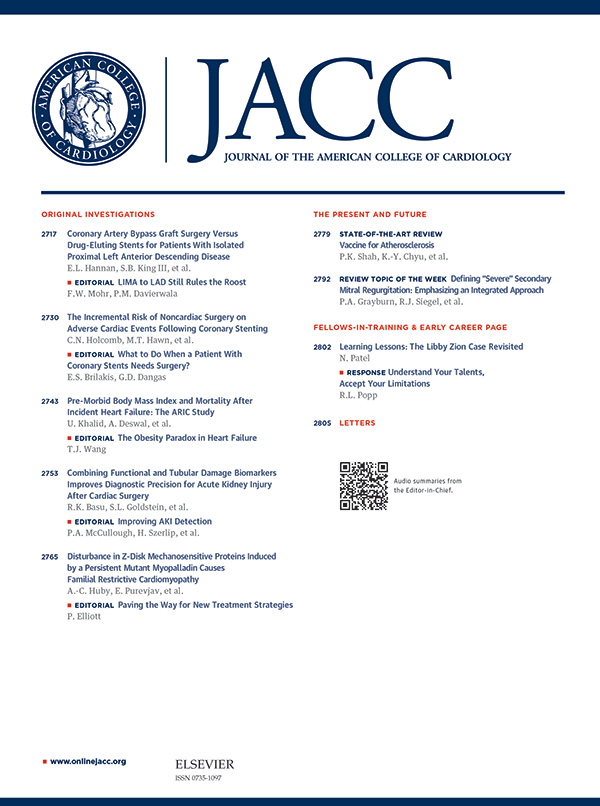Effect of Empagliflozin on the Mechanisms Driving Erythropoiesis and Iron Mobilization in Patients With Heart Failure
IF 21.7
1区 医学
Q1 CARDIAC & CARDIOVASCULAR SYSTEMS
引用次数: 0
Abstract
Background
Sodium-glucose cotransporter 2 (SGLT2) inhibitors stimulate erythropoiesis, but the mechanisms and clinical relevance of the effect of SGLT2 inhibitors on systemic iron metabolism in patients with heart failure is not well understood.
Objectives
The authors sought to characterize a comprehensive suite of iron metabolism biomarkers—particularly the erythroblast signaling molecule, erythroferrone—in patients with heart failure before and after short- and long-term treatment with empagliflozin in patients with heart failure and a reduced or preserved ejection fraction.
Methods
We measured serum iron metabolism biomarkers at baseline, 12 weeks, and 52 weeks in 1,139 patients who were treated with placebo or empagliflozin in the EMPEROR (EMPagliflozin outcomE tRial in Patients With chrOnic heaRt Failure) program, and we characterized the inter-relationships of these biomarkers with clinical status and with the effect of empagliflozin on erythropoiesis and heart failure outcomes.
Results
Correlations among iron biomarkers indicated the presence of a functional erythropoietin-erythroferrone–transferrin-receptor-protein-1 (TfR1)–hepcidin axis. As heart failure advanced, patients showed higher levels of erythropoietin, erythroferrone, and TfR1 (P trend <0.01), and levels of these proteins predicted a heightened risk of cardiovascular death or heart failure hospitalization (all P < 0.01). Compared with placebo, at 12 weeks, empagliflozin increased hemoglobin by 0.6 to 0.9 g/dL (P < 0.001), an effect that was accompanied by further activation of the erythropoietin-erythroferrone-TfR1 axis and increased iron use. Empagliflozin increased serum levels of erythroferrone by >40% (along with increases in erythropoietin and TfR1), while simultaneously decreasing hepcidin levels and reducing serum iron concentrations and transferrin saturation (all P < 0.01). When treated with empagliflozin, patients with evidence of iron deficiency at baseline showed attenuation of the erythrocytic response (P trend = 0.04) but no diminution of the heart failure benefits.
Conclusions
The erythropoietin-erythroferrone-TfR1-hepcidin axis is activated in patients with heart failure as the disease advances and is further heightened by SGLT2 inhibitors, in parallel with their effect to enhance erythropoiesis and iron mobilization and use. These changes have important implications for understanding the mechanism of action of SGLT2 inhibitors and for monitoring the response to treatment.

恩格列净对心力衰竭患者促红细胞生成和铁动员机制的影响
背景:钠-葡萄糖共转运蛋白2 (SGLT2)抑制剂刺激红细胞生成,但SGLT2抑制剂对心力衰竭患者全身铁代谢影响的机制和临床相关性尚不清楚。目的:作者试图描述一套全面的铁代谢生物标志物,特别是红细胞信号分子,红细胞铁素,在短期和长期使用恩格列净治疗心力衰竭患者并降低或保留射血分数之前和之后。方法:在EMPEROR (empagliflozin outcomes tRial in patients with chrOnic heaRt Failure)项目中,我们测量了1139名接受安慰剂或恩帕列净治疗的患者在基线、12周和52周时的血清铁代谢生物标志物,并表征了这些生物标志物与临床状态以及恩帕列净对红细胞生成和心力衰竭结局的影响之间的相互关系。结果铁生物标志物之间的相关性表明存在功能性促红细胞生成素-红细胞铁素-转铁素受体蛋白-1 (TfR1) -hepcidin轴。随着心力衰竭的进展,患者红细胞生成素、红细胞铁酮和TfR1水平升高(P趋势<;0.01),这些蛋白水平预示心血管死亡或心力衰竭住院的风险增加(P <;0.01)。与安慰剂相比,在12周时,恩格列净使血红蛋白增加0.6至0.9 g/dL (P <;0.001),这种效应伴随着促红细胞生成素-红细胞铁素- tfr1轴的进一步激活和铁的使用增加。依帕列净使血清红细胞铁素水平升高40%(同时促红细胞生成素和TfR1升高),同时降低肝铁素水平,降低血清铁浓度和转铁蛋白饱和度(所有P <;0.01)。当使用恩格列净治疗时,基线时有铁缺乏证据的患者红细胞反应减弱(P趋势= 0.04),但心力衰竭益处没有减少。结论促红细胞生成素-红细胞铁素- tfr1 -hepcidin轴在心力衰竭患者中随着病情的进展而被激活,SGLT2抑制剂进一步增强促红细胞生成素-红细胞铁素- tfr1 -hepcidin轴,与SGLT2抑制剂促进红细胞生成和铁的动员和使用的作用并行。这些变化对于理解SGLT2抑制剂的作用机制和监测治疗反应具有重要意义。
本文章由计算机程序翻译,如有差异,请以英文原文为准。
求助全文
约1分钟内获得全文
求助全文
来源期刊
CiteScore
42.70
自引率
3.30%
发文量
5097
审稿时长
2-4 weeks
期刊介绍:
The Journal of the American College of Cardiology (JACC) publishes peer-reviewed articles highlighting all aspects of cardiovascular disease, including original clinical studies, experimental investigations with clear clinical relevance, state-of-the-art papers and viewpoints.
Content Profile:
-Original Investigations
-JACC State-of-the-Art Reviews
-JACC Review Topics of the Week
-Guidelines & Clinical Documents
-JACC Guideline Comparisons
-JACC Scientific Expert Panels
-Cardiovascular Medicine & Society
-Editorial Comments (accompanying every Original Investigation)
-Research Letters
-Fellows-in-Training/Early Career Professional Pages
-Editor’s Pages from the Editor-in-Chief or other invited thought leaders

 求助内容:
求助内容: 应助结果提醒方式:
应助结果提醒方式:


